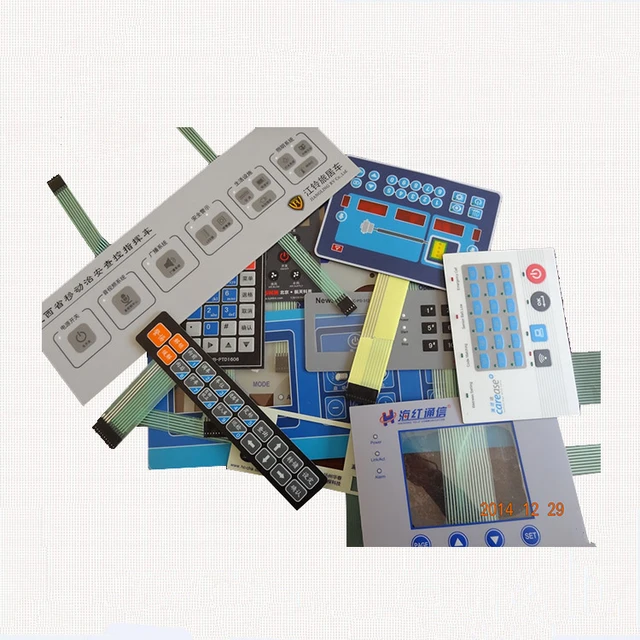Comprehending Membrane Layer Changes: The Trick to Trusted and sturdy Controls

What Are Membrane Switches?
Membrane buttons are a sophisticated remedy in the realm of interface innovation, combining performance and design flawlessly. These devices offer as an interface in between customers and electronic systems, integrating a number of elements right into a portable layout. Generally built from versatile, slim layers of products, membrane layer buttons are created to react to touch, making it possible for customers to interact with machinery and electronic devices effectively.
The primary elements of a membrane switch include a printed circuit layer, visuals overlay, and a spacer layer that prevents unintentional activation. The graphic overlay can be customized to reflect brand name identity or user choices, enhancing appearances while guaranteeing functionality. Membrane layer switches are generally made use of in various applications, consisting of medical tools, consumer electronics, and industrial tools, owing to their resilience and resistance to ecological aspects such as moisture and dirt.
One of the crucial advantages of membrane layer buttons is their ability to endure damage, making them perfect for high-traffic settings. Additionally, they are lightweight and require marginal area, enabling innovative layouts in product growth. On the whole, membrane layer switches stand for a functional and efficient choice for contemporary electronic user interfaces, marrying modern technology with user-centric design concepts.
Just How Membrane Layer Switches Job
The operation of membrane layer changes rest on a straightforward yet efficient device that translates customer input into digital signals. These switches contain multiple layers, normally including a visuals overlay, a spacer layer, and a circuit layer. When a user presses the button, the top layer warps, allowing a conductive element in the circuit layer to reach a matching conductive pad on the bottom of the graphic overlay. This call shuts the circuit and sends an electronic signal to the device, indicating that the button has actually been activated.
The design of membrane switches can vary, yet they often integrate domes or responsive components to provide comments to the individual, enhancing the general experience - membrane switch. The products made use of in membrane layer buttons, such as polyester or polycarbonate, add to their sturdiness and resistance to ecological aspects, consisting of dampness and dirt. Additionally, the published circuits are typically encapsulated, which protects them from wear and tear in time.
Benefits of Membrane Switches

Additionally, membrane buttons are known for their sturdiness. Built from durable products, they are immune to dust, wetness, and physical wear, which significantly extends their life expectancy compared to standard mechanical buttons. This resilience makes them specifically appropriate for high-traffic settings and applications calling for long life.
An additional significant benefit is the ease of cleaning and upkeep. The smooth blog here surface area of membrane layer switches over reduces dust build-up and is commonly resistant to spills, making them excellent for setups that call for constant sanitization.
Moreover, membrane layer buttons use a structured profile, resulting in a thinner design that can be integrated into various tools without including bulk. This feature not only improves the visual charm but also adds to an extra ergonomic product style.
Applications of Membrane Switches
Easy to use and versatile, membrane layer buttons locate applications across a vast array of markets, including clinical gadgets, consumer electronic devices, and commercial equipment. In the clinical field, these switches are indispensable to devices such as diagnostic tools, individual monitoring systems, and mixture pumps, where dependability and ease of cleansing are vital. Their capability to withstand rough atmospheres and maintain functionality makes them suitable for such applications.

In customer electronics, membrane layer buttons are made use of in items like microwaves, washing equipments, and remote controls - membrane switch. Their smooth layout enables for intuitive interface, boosting the overall individual experience while providing toughness and resistance to damage
Commercial equipment also takes advantage of membrane layer switches, particularly in control panels for equipment and automation systems. These buttons offer protection versus dirt and dampness, guaranteeing constant efficiency in tough environments. Moreover, their personalized attributes allow producers to tailor them to certain functional requirements, enhancing effectiveness and his comment is here performance.
Selecting the Right Membrane Change
When choosing a membrane switch, it is vital to think about different aspects that affect efficiency and viability for certain applications. The main considerations include environmental conditions, responsive responses, longevity, and layout specs.
First, examine the operating atmosphere; switches exposed to dampness, chemicals, or severe temperatures require specific products to make sure durability and performance. Next, review the demand for tactile feedback. Relying on individual interaction, some applications may gain from a tactile response to validate activation, while others might choose a non-tactile design for visual reasons.
Resilience is another essential aspect; membrane buttons must be developed to hold up against regular use, influences, and abrasion. Guarantee the selected button can endure the anticipated lifecycle, particularly in high-usage circumstances.

Verdict
To conclude, membrane switches serve as important elements in the layout of dependable and durable control systems throughout different industries. Their portable style, combined with durable construction and personalized functions, enhances customer interaction while ensuring durability in demanding settings. The flexibility of membrane layer changes enables customized services that fulfill certain operational requirements, reinforcing their relevance in modern innovation. As sectors remain to advance, the value of incorporating efficient membrane layer switch options can not be overemphasized.
Membrane changes stand for a crucial element of contemporary user interface layout, mixing functionality with durability in different applications.Membrane layer buttons are an innovative solution in the realm of user interface innovation, integrating performance and style flawlessly. Typically constructed from flexible, thin layers of materials, membrane switches are designed to respond to touch, enabling users to interact with machinery and electronic devices effectively.
The design of membrane layer buttons can differ, yet they usually include domes or responsive components to supply comments to the individual, improving the overall experience.In conclusion, membrane layer switches over offer as necessary elements in the style of reputable and resilient control systems across numerous sectors.